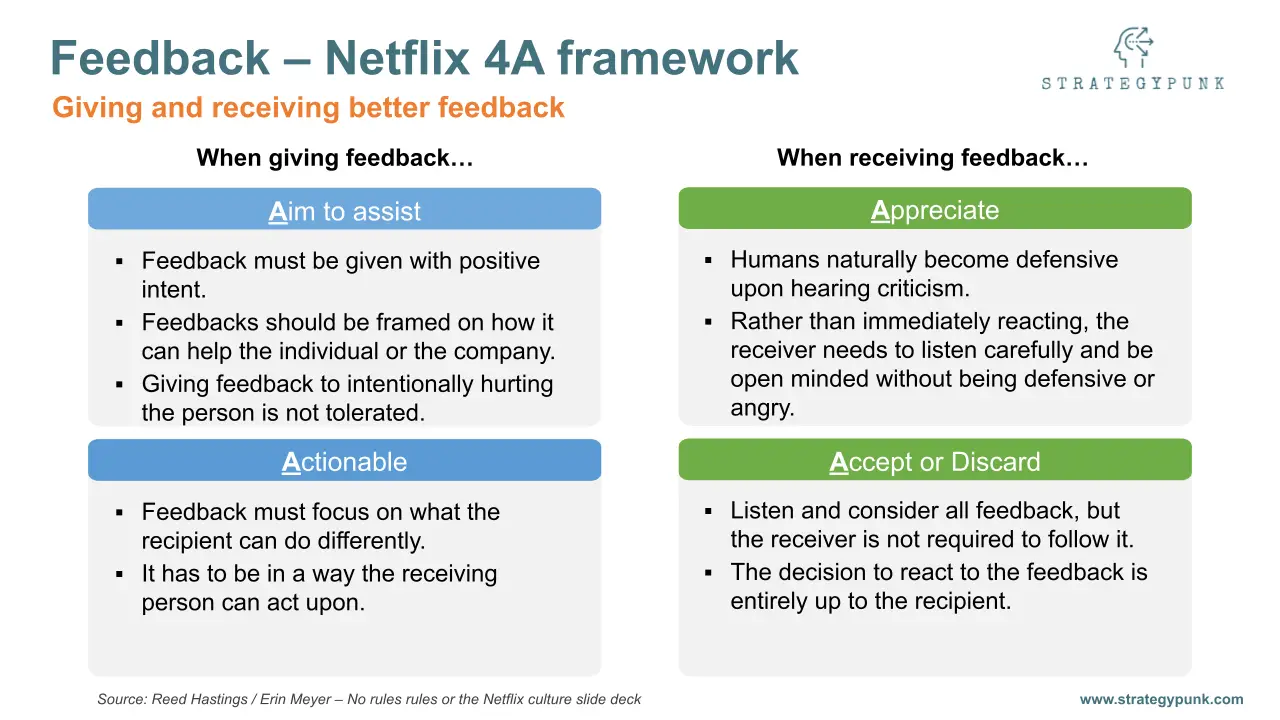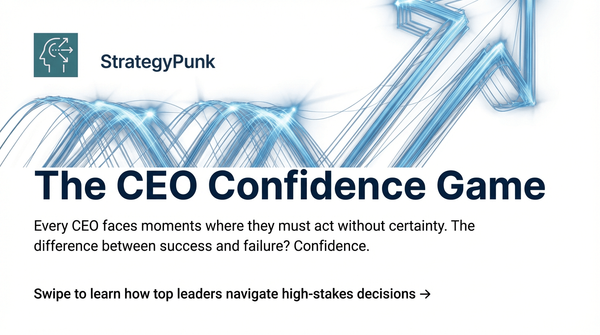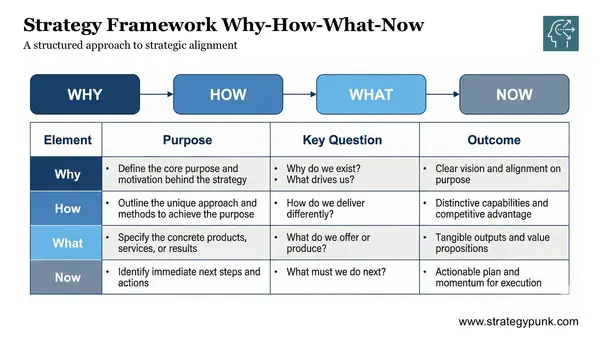Netflix 4A Feedback Framework: Building High-Performance Culture
Master Netflix's 4A feedback framework for high-performance teams. Complete 2025 guide + free PowerPoint template. Build better culture today!

Netflix has evolved from a DVD-by-mail service to one of the world's most influential entertainment companies, fundamentally reshaping how we consume media. But beyond its streaming success lies an equally impressive organizational achievement: creating a culture where candid feedback drives continuous improvement and exceptional performance.
The company's market valuation exceeding $150 billion reflects not just its content strategy, but the effectiveness of its people practices. At the heart of Netflix's cultural success lies the 4A feedback framework — a systematic approach to giving and receiving feedback that has become a cornerstone of high-performance organizations worldwide.
In 2024, Netflix underwent its most significant culture memo revision in years, moving from "Freedom and Responsibility" to "People Over Process" and incorporating feedback from over 1,500 employees.
This evolution reinforces that even the most successful cultures must adapt to remain effective in our changing workplace landscape.
Why Feedback Culture Matters More Than Ever
The modern workplace presents unprecedented challenges for effective communication. Remote and hybrid teams struggle with context loss, cultural differences create communication barriers, and the pace of change demands faster learning cycles. Organizations that master feedback culture gain significant competitive advantages:
- Accelerated Learning: Teams that give and receive feedback effectively adapt faster to market changes
- Enhanced Innovation: Psychological safety created through good feedback practices encourages risk-taking and creative problem-solving
- Improved Retention: Employees who receive regular, quality feedback are 3.2x more likely to be engaged at work
- Stronger Performance: Companies with effective feedback cultures show 14.9% lower turnover rates
Netflix recognized early that feedback isn't just about performance reviews—it's about creating an environment where everyone can perform at their best.
Understanding Netflix's 4A Feedback Framework
The 4A framework emerged from Netflix's recognition that most feedback fails because it lacks structure, clear intent, or proper reception. Reed Hastings and the Netflix leadership team, working with culture expert Erin Meyer, developed these four principles as outlined in "No Rules Rules":
The Four A's Explained
When Giving Feedback:
- Aim to Assist - Feedback must be given with positive intent
- Make it Actionable - Focus on what the recipient can do differently
When Receiving Feedback: 3. Show Appreciation - Listen with an open mind, without defensiveness 4. Accept or Discard - You choose what to do with the feedback
This framework works because it addresses both sides of the feedback equation while providing clear behavioral guidelines that anyone can follow.
Deep Dive: The Four A's in Practice
1. Aim to Assist: Leading with Genuine Intent
The foundation of effective feedback lies in an authentic desire to help. "Aim to Assist" means your feedback should genuinely help the individual or the organization improve, never to hurt, embarrass, or assert dominance.
What This Looks Like:
- Before giving feedback, ask yourself: "Will this genuinely help this person succeed?"
- Frame feedback around impact and potential solutions
- Consider timing—deliver feedback when the person can best receive and act on it
- Focus on behavior and outcomes, not personality traits
Common Mistakes to Avoid:
- Giving feedback when you're frustrated or angry
- Using feedback as a way to vent or criticize
- Offering vague observations without a clear intent for assistance
- Delivering feedback publicly when it should be private
Remote Work Considerations: In virtual environments, intent can be easily misread. Extra care in word choice and context-setting becomes crucial. Consider scheduling dedicated feedback conversations rather than dropping feedback in chat or email.
Example in Action: Instead of: "Your presentation was confusing and hard to follow." Try: "I want to help you make your presentations even more impactful. I noticed some areas where we could enhance clarity to ensure your great ideas land with the audience."
2. Make it Actionable: Specific Steps for Improvement
Actionable feedback focuses on what someone can do differently. It's specific, observable, and within the person's control to change.
What This Looks Like:
- Provide concrete examples of the behavior or situation
- Suggest specific alternatives or improvements
- Focus on actions, not abstract concepts
- Ensure the person has the resources and capability to act on your feedback
The Actionability Test: Ask yourself, "Could this person walk away and immediately know what to do differently?" If not, your feedback needs more specificity.
Examples of Actionable vs. Non-Actionable Feedback:
Non-Actionable: "You need to be more strategic in your thinking." Actionable: "In tomorrow's client meeting, try opening with the business impact first, then diving into tactical details. This will help the executives stay engaged with your recommendations."
Non-Actionable: "Your code quality needs improvement." Actionable: "Consider breaking this 200-line function into smaller, single-purpose functions. Here's a refactoring example that might help."
Cultural Adaptation: Different cultures respond to directness differently. While maintaining actionability, adjust your communication style to match cultural expectations while preserving the concrete nature of your suggestions.
3. Show Appreciation: Receiving Feedback with Grace
Appreciation doesn't mean agreeing with everything—it means genuinely valuing that someone took time to help you improve. This is often the most challenging aspect of the framework because it requires overcoming natural defensive responses.
What This Looks Like:
- Listen without immediately defending or explaining
- Ask clarifying questions to understand the feedback better
- Thank the person for taking the time to help you improve
- Avoid dismissing feedback, even if you initially disagree
Overcoming Defensive Reactions:
- Pause before responding to process the feedback emotionally
- Remember that feedback is about behavior, not your worth as a person
- Consider that the feedback might contain valuable insights even if the delivery isn't perfect
- View feedback as data points rather than judgments
In Virtual Environments, the absence of body language cues makes showing appreciation more critical. Verbal acknowledgment and follow-up questions demonstrate that you're actively receiving the feedback.
Practical Techniques:
- Use phrases like "Thank you for sharing that perspective" or "I appreciate you taking time to help me improve."
- Ask follow-up questions: "Can you help me understand what that would look like in practice?"
- Summarize what you heard to confirm understanding: "Let me make sure I understand your suggestion correctly..."
4. Accept or Discard: Your Choice, Your Ownership
The final A empowers the feedback recipient with choice. Not all feedback will be correct for every situation, but all input deserves consideration.
What This Looks Like:
- Consider all feedback seriously, even if you ultimately choose not to act on it
- Make conscious decisions about which feedback to implement
- Communicate your decisions when appropriate, especially to managers or frequent feedback givers
- Own the consequences of your choices
The Power of Choice: This principle prevents feedback culture from becoming oppressive or overwhelming. Knowing you have a choice makes you more likely to listen openly and consider feedback seriously.
Decision Framework: When deciding whether to accept or discard feedback, consider:
- Does this align with my goals and values?
- Do I have the resources and capability to implement this change?
- Would implementing this feedback benefit me, my team, or the organization?
- Is the feedback consistent with other input I've received?
Communication About Your Choices: While you're not required to implement all feedback, communicating your thought process helps maintain relationships and shows you took the feedback seriously.
Implementation Guide: Building 4A Culture in Your Organization
Phase 1: Leadership Alignment and Modeling
Success starts with leadership commitment. Leaders must model the 4A principles consistently before expecting others to adopt them.
Leadership Actions:
- Practice giving 4A feedback in leadership team meetings
- Share examples of feedback you've received and how you've chosen to accept or discard it
- Create psychological safety by acknowledging your own mistakes and areas for improvement
- Establish regular feedback practices in leadership routines
Phase 2: Team Training and Practice
Implement structured learning experiences that help teams practice the 4A principles in low-stakes environments.
Training Components:
- Workshop sessions explaining each principle with examples
- Role-playing exercises using real scenarios
- Peer feedback practice sessions
- Regular check-ins on feedback culture development
Practice Structures:
- Monthly team feedback rounds where everyone practices giving and receiving 4A feedback
- Project retrospectives that specifically use the 4A framework
- Pair programming or collaboration sessions with built-in feedback moments
- Cross-functional feedback exchanges
Phase 3: System Integration
Embed 4A principles into existing organizational systems and processes.
Integration Points:
- Performance review processes that explicitly use the 4A structure
- Meeting protocols that include feedback moments
- Project management templates that incorporate feedback checkpoints
- Onboarding programs that teach 4A principles to new hires
Phase 4: Measurement and Refinement
Track the effectiveness of your feedback culture and continuously improve.
Success Metrics:
- Employee engagement scores related to feedback and development
- Frequency and quality of peer feedback exchanges
- Performance improvement rates following feedback
- Retention rates of high performers
Case Studies: 4A Framework Across Different Contexts
Case Study 1: Remote Software Development Team
Challenge: A distributed development team struggled with code quality and collaboration across time zones.
4A Implementation:
- Aim to Assist: Code reviews framed as helping teammates write better code rather than finding flaws
- Actionable: Specific suggestions with code examples and links to resources
- Appreciate: Standard practice of thanking reviewers and asking clarifying questions
- Accept/Discard: Developers explicitly communicated which suggestions they implemented and why
Results: Code review participation increased 40%, bug rates decreased 25%, and team satisfaction scores improved significantly.
Case Study 2: Marketing Agency Client Feedback
Challenge: A creative agency needed to help clients give better feedback on creative work to improve outcomes and reduce revision cycles.
4A Implementation:
- Trained clients on giving feedback that aims to assist the creative vision
- Provided templates for actionable creative feedback
- Modeled appreciation for client input during presentations
- Gave clients explicit permission to discard suggestions that didn't align with their brand vision
Results: Average revision cycles decreased from 4.2 to 2.1, client satisfaction increased, and creative quality improved.
Case Study 3: Healthcare Quality Improvement
Challenge: A hospital needed to improve patient safety through better communication between departments.
4A Adaptation:
- Aim to Assist: All feedback focused on patient outcomes and safety
- Actionable: Specific protocols and procedures for improvement
- Appreciate: Structured debriefs that honored all perspectives
- Accept/Discard: Department leads are empowered to adapt suggestions to their specific contexts
Results: Patient safety incidents decreased 15%, inter-departmental cooperation improved, and staff satisfaction increased.
Tools and Resources for Implementation
Digital Tools That Support 4A Feedback
For Remote Teams:
- Structured feedback templates in Slack or Teams
- Video feedback using Loom or similar tools for nuanced communication
- Collaborative documents for ongoing feedback exchange
- Calendar blocking for dedicated feedback conversations
Documentation and Tracking:
- Feedback logs that track patterns and improvement over time
- Goal-setting templates that incorporate received feedback
- Team dashboards showing feedback culture health metrics
Workshop Facilitation Guide
90-Minute 4A Workshop Structure:
Opening (15 minutes)
- Netflix culture overview and 4A introduction
- Personal feedback experiences discussion
Practice Session 1 (25 minutes)
- Giving feedback: Aim to Assist and Actionable
- Role-play exercises with real scenarios
- Group debrief on challenges and insights
Practice Session 2 (25 minutes)
- Receiving feedback: Appreciate and Accept/Discard
- Partner exercises with feedback exchange
- Discussion on overcoming defensive reactions
Integration Planning (20 minutes)
- Team commitments to practicing 4A principles
- Identification of specific opportunities to apply the framework
- Follow-up planning and accountability partnerships
Wrap-up (5 minutes)
- Key takeaways and resources for continued learning
Assessment Tools
Individual 4A Readiness Assessment: Rate yourself on each dimension:
- How often do you give feedback with genuine intent to assist?
- How specific and actionable is your typical feedback?
- How well do you receive feedback without becoming defensive?
- How thoughtfully do you evaluate which feedback to implement?
Team Culture Assessment:
- Frequency of peer feedback exchange
- Quality of feedback conversations
- Psychological safety levels
- Improvement in performance following feedback
Overcoming Common Implementation Challenges
Challenge 1: "We Don't Have Time for All This Feedback"
Solution: Start small and integrate feedback into existing activities rather than creating separate feedback sessions. Five minutes of 4A feedback in a regular meeting is more valuable than elaborate feedback sessions that happen rarely.
Challenge 2: "People Are Too Sensitive to Receive Direct Feedback"
Solution: Focus heavily on "Aim to Assist" and building psychological safety. Often, perceived sensitivity is a response to poorly delivered feedback. When people trust your intent, they're much more open to direct input.
Challenge 3: "Our Culture Is Too Hierarchical for Peer Feedback"
Solution: Start with upward feedback and leader modeling. When employees see leaders receiving and implementing feedback gracefully, it creates permission for peer-to-peer feedback exchange.
Challenge 4: "Remote Work Makes Feedback Too Impersonal"
Solution: Leverage video calls for meaningful feedback conversations, use voice messages for context, and create more frequent but shorter feedback touchpoints rather than infrequent, lengthy sessions.
The Future of Feedback Culture
As workplaces continue evolving, the 4A framework provides a stable foundation while adapting to new contexts:
Emerging Trends:
- AI-assisted feedback preparation (while maintaining human delivery)
- Virtual reality training for difficult feedback conversations
- Real-time feedback integration with productivity tools
- Cross-cultural adaptation frameworks for global teams
Sustainability Considerations:
- Preventing feedback fatigue through balanced frequency
- Maintaining quality while scaling feedback practices
- Balancing transparency with psychological safety
- Long-term culture maintenance through leadership transitions
The key is maintaining the human elements—genuine care, specific helpfulness, grateful receiving, and thoughtful decision-making—while leveraging technology to make feedback more effective and accessible.
Conclusion: Your Path to 4A Mastery
Netflix's 4A feedback framework succeeds because it provides structure without stifling authenticity, encourages candor while maintaining relationships, and empowers individuals while serving organizational goals. The framework's simplicity makes it memorable and actionable, while its depth supports sophisticated organizational culture development.
Implementing 4A feedback culture isn't about perfection—it's about progress. Start with yourself, practice the principles consistently, and gradually expand to your team and organization. Remember that building a feedback culture is itself an iterative process that benefits from the very principles it teaches.
The organizations that master feedback culture will have significant advantages in attracting talent, accelerating performance, and adapting to change. Netflix's continued success demonstrates that investing in how people communicate and grow together pays dividends far beyond any single business strategy.
Your journey to 4A mastery begins with your following the feedback conversation. Will you aim to assist, make it actionable, show appreciation, and thoughtfully choose what to accept or discard?
Netflix 4A feedback template
Ready to implement 4A feedback in your organization?
Download our comprehensive toolkit, including workshop guides, assessment tools, and customizable templates, to get started immediately.
Free Resources Available:
- 4A Feedback PowerPoint Template (Updated 2025)
- Workshop Facilitation Guide
- Team Assessment Tools
- Implementation Roadmap
- Case Study Collection
Transform your organizational culture one feedback conversation at a time.
Please subscribe and sign in to download all the published templates on StrategyPunk for free (Google Slides or PowerPoint format).





